Embark on a culinary journey to create a dish that is as vibrant and flavorful as it is incredibly quick to prepare. This effortless recipe for Sauteed Baby Bok Choy with Ginger and Scallions elevates the humble bok choy into a star side dish, bursting with aromatic ginger and crisp scallions. Perfect for busy weeknights, this Asian-inspired vegetable stir-fry takes a mere 10 minutes from start to finish, offering a delightful way to infuse more greens into your diet without compromising on taste or precious time. Its versatility makes it an ideal companion to virtually any main course, promising a delicious and nutritious addition to your table.
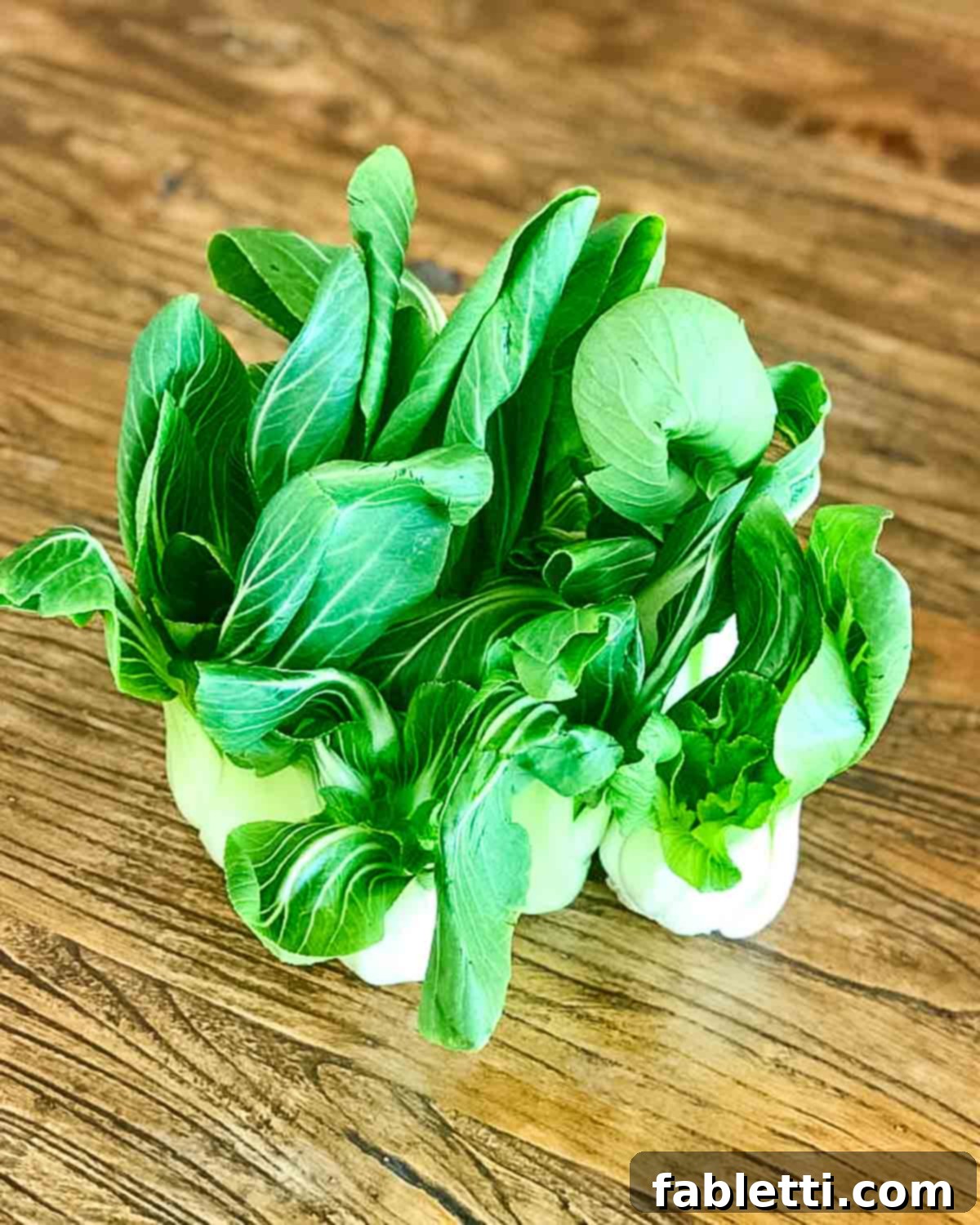
If you’ve been searching for an irresistible method to boost your vegetable intake, look no further than this exquisite Ginger Scallion Bok Choy recipe. It delivers a remarkable flavor profile, where the pungent warmth of ginger and garlic harmonizes with the fresh, zesty bite of scallions. The textural contrast is equally captivating: the crunchy white stems of the bok choy provide a satisfying bite, beautifully complemented by the tender, slightly sweet, leafy green tops. This combination creates an experience that is truly irresistible and effortlessly delicious, transforming a simple vegetable into a memorable culinary highlight.
Why You’ll Love This Easy Bok Choy Recipe
Discover multiple reasons why this Sauteed Baby Bok Choy with Ginger and Scallions will quickly become a cherished favorite in your kitchen:
- Lightning-Fast Preparation: You can have this entire dish on the table in just 10 minutes, making it an absolute lifesaver for frantic weeknights when time is of the essence. From prep to plate, efficiency is key, and this recipe delivers.
- Minimal Cleanup: Requiring only one pan or wok, this recipe drastically reduces your post-meal cleanup time. Spend less time washing dishes and more time enjoying your delicious, healthy creation.
- Nutrient Powerhouse: Despite its low calorie and carbohydrate count, bok choy is remarkably rich in essential vitamins and minerals. This dish is a fantastic way to consume a high volume of nutrition without heavy fats or sugars.
- Explosion of Flavor: The potent combination of fresh ginger, fragrant garlic, and vibrant scallions infuses the bok choy with an incredible depth of savory, slightly spicy, and aromatic flavor that is far from bland.
- Versatile Pairing: This healthy bok choy side dish complements a wide array of cuisines, from grilled chicken and fish to rice bowls and noodles. It’s an adaptable addition to almost any meal.
- Effortless Technique: Even beginner cooks will find this recipe simple to master. The straightforward steps guarantee success, building confidence in the kitchen.
Health Benefits of Ginger Scallion Bok Choy: A Nutritional Powerhouse
Beyond its delicious taste, this Ginger Scallion Bok Choy dish offers a wealth of health advantages, making it an excellent choice for a balanced diet:
- Bok Choy’s Antioxidant Richness: Bok choy is a phenomenal source of antioxidants, particularly Vitamins A and C. These vital nutrients play a crucial role in protecting your cells from oxidative damage caused by free radicals. This cellular protection contributes to overall well-being and may help reduce the risk of chronic diseases. Furthermore, the Vitamin A content is especially beneficial for eye health, potentially lowering the risk of age-related macular degeneration.
- Bone Health Support: This leafy green vegetable contains a significant amount of calcium, magnesium, phosphorus, and Vitamin K. These minerals and vitamins are fundamental building blocks for strong bones, contributing to bone density and strength. Vitamin K, in particular, is essential for proper blood clotting, showcasing bok choy’s comprehensive support for various bodily functions.
- Cruciferous Cancer-Fighting Properties: As a member of the cruciferous vegetable family (alongside broccoli, cauliflower, and kale), bok choy contains compounds like glucosinolates. These compounds have been extensively studied for their potential to reduce the risk of certain cancers, including breast, prostate, lung, and digestive tract cancers, by aiding detoxification processes in the body.
- Ginger’s Anti-Inflammatory & Digestive Aid: Fresh ginger is renowned for its powerful anti-inflammatory properties, which can help alleviate pain and reduce swelling throughout the body. Moreover, ginger is a fantastic digestive aid, known to soothe upset stomachs, reduce nausea, and promote healthy digestion by stimulating digestive enzymes.
- Garlic’s Immune-Boosting and Cardiovascular Benefits: Garlic is a potent natural immune booster, thanks to its allicin content. Regular consumption of garlic has been linked to a reduced risk of common colds and infections. Beyond immunity, studies suggest that garlic can contribute to cardiovascular health by helping to lower blood pressure and reduce cholesterol levels, supporting a healthy heart.
Ingredients and Clever Substitutions for Sauteed Bok Choy
Crafting the perfect Sauteed Baby Bok Choy starts with fresh, quality ingredients. Here’s what you’ll need, along with smart substitutions to adapt to your pantry or dietary needs:
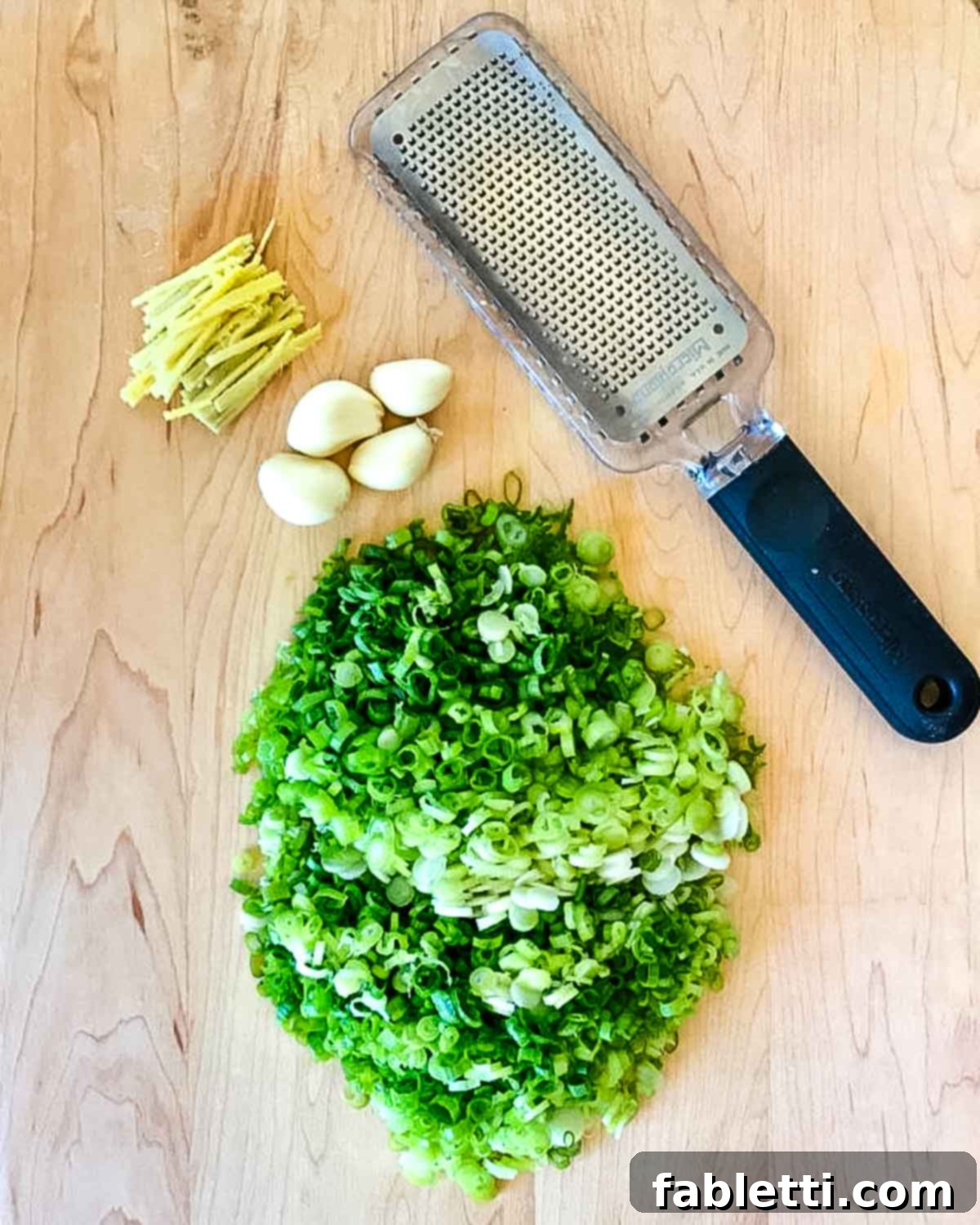
- Baby Bok Choy: The star of our dish! Baby bok choy is preferred for its tender leaves and delicate crunch. If smaller heads are unavailable, a large bok choy can be used—simply chop it roughly into bite-sized pieces, separating the white stems from the green leaves for staggered cooking.
- Scallions (Green Onions): These provide a mild oniony flavor and a beautiful green garnish. For a slightly different but equally delicious aromatic base, you can substitute with thinly sliced shallots or the white and light green parts of leeks, finely diced.
- Fresh Ginger: The pungent, spicy warmth of fresh ginger is key to this dish’s vibrant flavor. While a ¼ teaspoon of ground ginger can work in a pinch, it won’t deliver the intense, bright flavor and aromatic complexity of freshly grated or julienned ginger. Always opt for fresh if possible.
- Garlic: Fresh garlic offers an unparalleled depth of flavor. Aim for finely grated or minced cloves to distribute its powerful taste evenly. If using dried, ensure it’s garlic powder (not garlic salt) to control sodium levels, and use a smaller quantity as dried garlic is more concentrated.
- Sesame Oil: Toasted sesame oil is my preference due to its rich, nutty, and robust flavor that enhances the Asian profile of the dish. Regular sesame oil will also work. For an extra boost of sesame aroma and texture, consider sprinkling some toasted sesame seeds over the finished dish.
- Tamari: I recommend low-sodium tamari as a gluten-free alternative to traditional soy sauce, and it naturally reduces the overall sodium content without sacrificing savory depth. If gluten isn’t a concern, low-sodium soy sauce can be used.
- Rice Vinegar: This adds a touch of acidity and brightness, balancing the savory and spicy notes. Always opt for an unsweetened variety; check the ingredient label carefully, as some rice vinegars contain added sugar that can alter the dish’s flavor profile.
- Water: A small amount of water helps create a steaming environment, ensuring the bok choy cooks tender-crisp and absorbs the flavors of the sauce.
- Coarse Sea Salt & Crushed Red Pepper: For seasoning and a touch of heat. Adjust the red pepper flakes to your preferred spice level, or omit for a milder version.
How to Clean and Cut Bok Choy Like a Pro
Proper preparation of bok choy is essential for both cleanliness and optimal texture. Follow these simple steps to ensure your bok choy is perfectly ready for sautéing:
- Initial Inspection and Trim: Begin by carefully inspecting each head of bok choy. Remove and discard any outer leaves that appear wilted, damaged, or discolored. Trim off the very end of the root base, but keep enough of the core intact to hold the leaves together during cleaning.
- Halving or Quartering: For baby bok choy, simply cut each head in half lengthwise, right through the core. If you are using larger heads of bok choy, cut them lengthwise into quarters. This exposes the inner layers where dirt often hides and allows for even cooking.
- Thorough Washing: Bok choy can sometimes harbor a lot of dirt, especially at the base of the stems. If your bok choy appears particularly sandy or dirty, consider soaking the halved or quartered pieces in a bowl of cold water for a few minutes. This helps to dislodge stubborn grit. Otherwise, hold the pieces under cold running water, fanning out the leaves slightly and using your fingers to gently rub away any dirt or debris caught between the layers. Repeat this process until the water runs clear.
- Drying is Key: After rinsing, it’s crucial to thoroughly pat the bok choy dry with a clean kitchen towel or use a salad spinner. Excess water will steam the bok choy instead of sautéing it, preventing it from achieving that desirable tender-crisp texture.

For baby bok choy, especially if the white stems are quite thick, you can cut through the white parts on a long diagonal. This creates more surface area for cooking and makes them easier to eat. Keep the green leafy tops separate if you plan to add them slightly later, as they cook much faster.
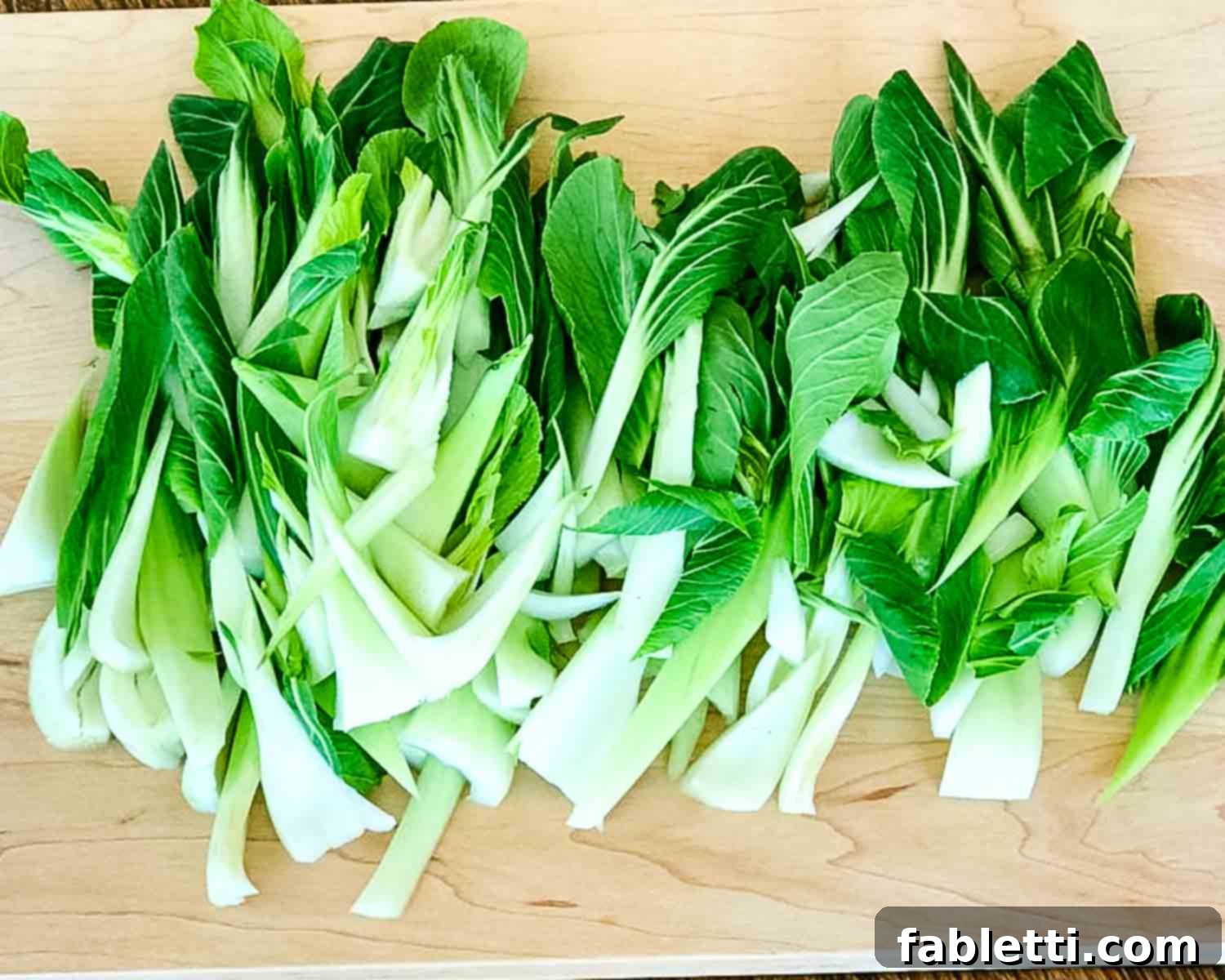
How to Make This Flavorful Ginger Scallion Bok Choy
Whipping up this incredibly delicious Sauteed Bok Choy is quicker than ordering takeout. Follow these straightforward steps for a perfectly cooked dish every time:
- Prepare Your Aromatics: Begin by finely preparing your flavor base. Thinly slice the scallions, separating the white and green parts if you prefer to add the greens later for garnish. Peel the fresh ginger and cut it into small matchsticks (julienne) or grate it using a microplane for maximum flavor release. Finally, use a microplane or fine grater to grate the garlic cloves into a paste-like consistency.
- Combine the Flavor Paste: In a small glass bowl, combine the prepared scallions (white and light green parts), ginger, grated garlic, coarse sea salt, and a pinch of crushed red pepper (adjust to your heat preference). Stir these ingredients together thoroughly. This mixture will form the aromatic foundation of your dish.
- Heat the Pan and Infuse Aromatics: Place a heavy skillet or a wok over medium-high heat. Allow it to heat up sufficiently before adding the sesame oil. Once the oil is shimmering, add the scallion-ginger-garlic mixture. Cook for approximately 1 minute, pressing down lightly on the aromatics with your spatula or tongs. You’ll notice an incredibly fragrant aroma filling your kitchen – this signifies that the flavors are blooming. Be careful not to burn the garlic.
- Whisk in the Sauce Liquids: To the fragrant aromatics in the pan, mix in the tamari, rice vinegar, and water. Stir well to combine, allowing the sauce to gently heat through and slightly thicken. This forms the flavorful liquid that the bok choy will absorb.
- Add and Cook the Bok Choy: Carefully add the prepared bok choy (white stems first if larger, then greens, or all at once for baby bok choy) to the pan. Cook, stirring continuously with tongs, ensuring all pieces are coated in the sauce and exposed to the heat. The goal is to cook until the leafy green parts are just wilted, while the white, crunchy stems still retain a pleasant crispness. This delicate balance typically takes about 2 minutes. Overcooking will result in soggy bok choy, so watch it closely!
- Serve and Store: Your Sauteed Baby Bok Choy with Ginger and Scallions is now ready! Serve it warm immediately as a delightful side dish, or allow it to cool and enjoy it at room temperature. Any leftovers can be stored in an airtight container in the refrigerator for up to 5 days. It’s surprisingly tasty when eaten cold, too!
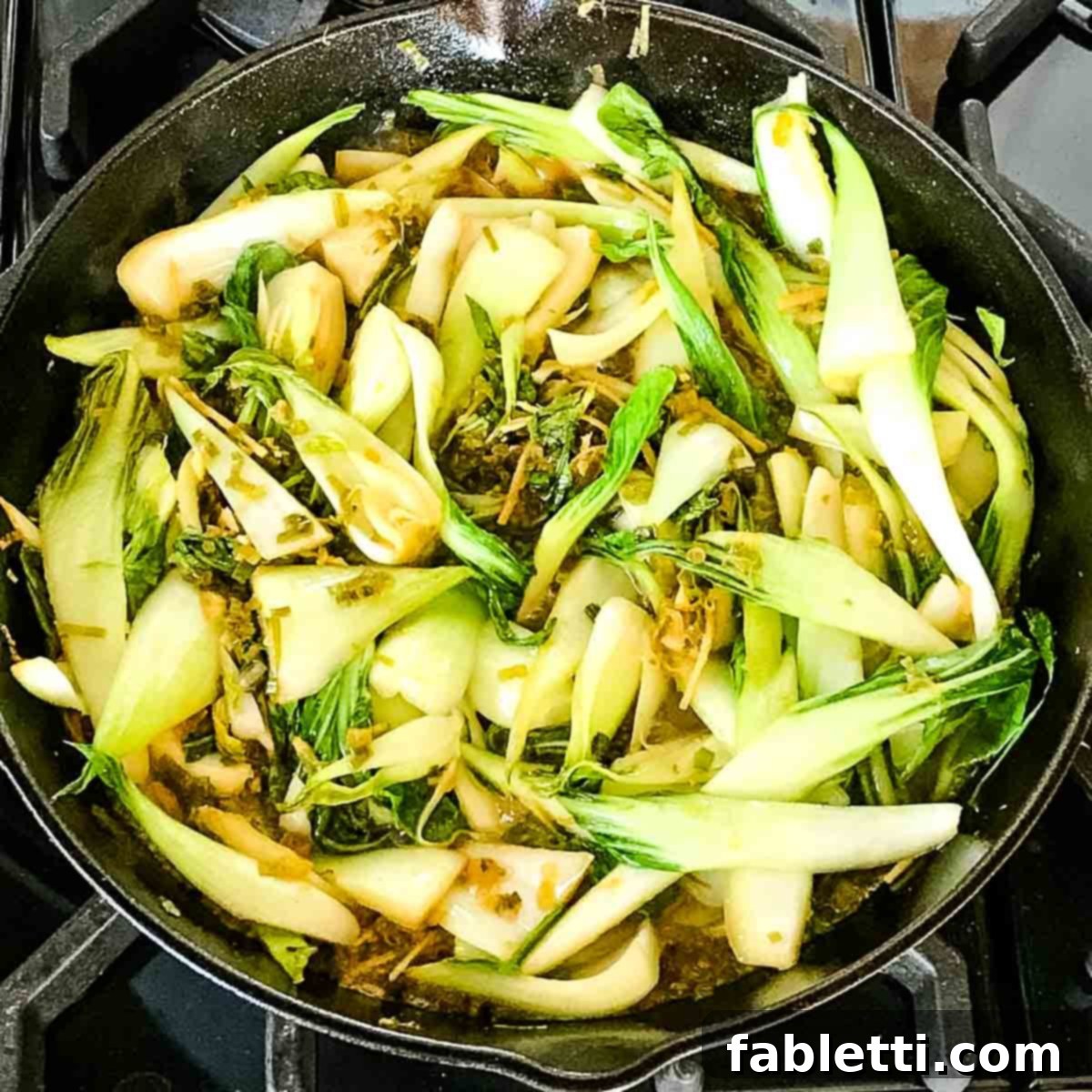
Expert Tips for the Best Sauteed Bok Choy
- High Heat is Your Friend: Use a hot pan or wok over medium-high heat to achieve a proper sauté rather than steaming. This ensures the bok choy browns slightly and develops a delicious, tender-crisp texture.
- Don’t Crowd the Pan: If cooking a large batch, sauté the bok choy in two batches. Overcrowding the pan will lower the temperature, leading to steamed, rather than sautéed, bok choy.
- Staggered Cooking for Texture: If using larger bok choy or if you prefer a more distinct texture, add the tougher white stems to the pan first and cook for about a minute before adding the delicate green leaves. This ensures both parts are cooked to perfection.
- Adjust Seasoning to Taste: Taste the dish before serving and adjust salt, tamari, or rice vinegar as needed. You might want a touch more acidity or umami depending on your preference.
- Garnish for Freshness: A sprinkle of fresh chopped scallion greens or toasted sesame seeds just before serving adds an extra layer of flavor and visual appeal.
Serving Suggestions & More Ideas for Bok Choy
This Ginger Scallion Bok Choy is wonderfully versatile. Here are some ways to enjoy it and integrate bok choy into other dishes:
- As a Side Dish: It’s the perfect accompaniment to grilled fish, chicken, tofu, or steak. Serve alongside a bowl of steamed jasmine rice for a complete and satisfying meal.
- Stir-Fry Addition: Incorporate this sauteed bok choy directly into a larger stir-fry with your favorite protein and other vegetables. Add it towards the end of the cooking process to maintain its texture.
- Salads and Slaws: Thinly slice raw bok choy (especially baby bok choy) crosswise and add it to your favorite salads or slaws for a crisp, fresh bite. It’s particularly good in vibrant Asian-inspired salads, like a ginger miso summer slaw or a hearty Tuscan kale chopped salad for added crunch.
- Soups and Noodle Dishes: Bok choy is an excellent addition to various soups and noodle bowls. Add it towards the end of cooking your simple miso soup with vegetables; the stems will retain a pleasing crunch while the greens beautifully wilt into the broth, adding color and nutrients.
- Light Lunch: Enjoy a larger portion of this bok choy with a fried egg on top for a quick, healthy, and satisfying lunch.

Your feedback is invaluable! If you enjoyed making this recipe, please consider leaving a five-star rating and a comment below. We love seeing your culinary creations! Share your photos on Instagram by tagging me @dkhealthcoach and using the hashtag #debraklein.
📖 Recipe Card: Ginger Scallion Bok Choy
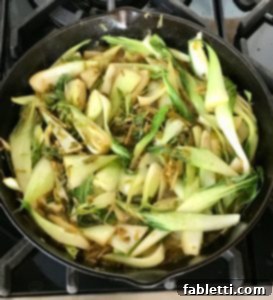
Ginger Scallion Bok Choy
Author: Debra Klein
The tastiest way to eat bok choy. 5 minutes to a super flavorful side dish that happens to be good for you too.
Average Rating: 4.50 from 2 votes
Pin Recipe
Ingredients
- 2 lbs baby bok choy, trimmed and halved
- 2 bunches scallions, thinly sliced
- 2” knob fresh ginger, peeled and cut into matchsticks
- 4 cloves garlic, finely grated
- ¼ teaspoon coarse sea salt
- Pinch of crushed red pepper
- 2 Tablespoons sesame oil
- 2 Tablespoons tamari (low-sodium, gluten-free preferred)
- 2 Tablespoons unseasoned rice vinegar
- 2 Tablespoons water
Instructions
- In a medium glass bowl, stir together the sliced scallions, matchstick ginger, grated garlic, coarse sea salt, and crushed red pepper. Set this aromatic mixture aside.
- Prepare the bok choy: First, discard any wilted outer leaves. Then, cut each head in half lengthwise through the core. For larger heads of bok choy, cut them lengthwise into quarters. If the pieces are still large, cut through the white parts on a long diagonal for easier eating. Rinse the bok choy thoroughly under running water, ensuring all dirt is removed, and pat dry completely.
- Heat the sesame oil in a wok or large skillet over medium-high heat. Once hot and shimmering, add the reserved scallion mixture. Cook for about 1 minute, pressing down gently with your spatula or tongs, until the aromatics become incredibly fragrant. Be careful not to burn the garlic.
- Pour in the tamari, unseasoned rice vinegar, and water into the pan with the aromatics. Stir well to combine all the sauce ingredients.
- Add the prepared bok choy to the pan. Cook, stirring continuously with tongs, for about 2 minutes. The goal is for the leafy green parts to just wilt, while the white stems remain tender-crisp. Avoid overcooking to prevent sogginess.
- Serve the Ginger Scallion Bok Choy warm as a side dish, or allow it to cool and serve at room temperature. Store any leftovers in an airtight container in the refrigerator for up to 5 days. It’s also delicious enjoyed cold!
Notes
If baby bok choy is not available, you can use 3 heads of regular-sized bok choy. Trim them and cut lengthwise into quarters before proceeding with the recipe.
Nutrition
Serving: 1g
Calories: 102 kcal
Carbohydrates: 6g
Protein: 5g
Fat: 7g
Saturated Fat: 1g
Polyunsaturated Fat: 6g
Sodium: 714mg
Fiber: 3g
Sugar: 2g
Note
The nutrition calculations were performed using online tools. For the most precise nutritional information for any given recipe, it is recommended to calculate the values with the actual ingredients you use. You are ultimately responsible for verifying the accuracy, completeness, and utility of any nutritional information provided.
Did you make this recipe?
Please leave a review below, then snap a picture and tag me @dkhealthcoach or use hashtag #dkhealtcoach on Instagram so I can see it!!
